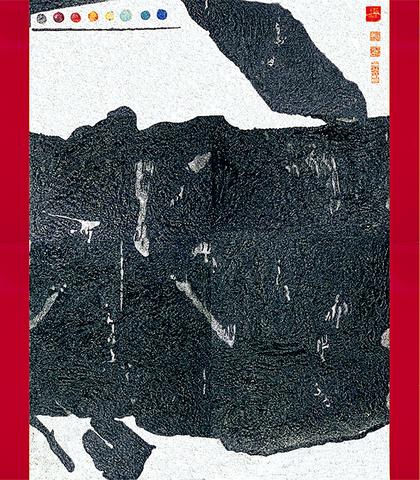"The bases for artistic ideas can be many and various. But to me, the most important thing is a national basis, a traditional orientation," said Lee Hsi-chi (
In Ten Aspects of My Artistic Life (浮生十帖), Lee's current exhibition at the National Museum of History (國立歷史博物館), the 64-year-old painter is showing his latest experiments with rearrangeable plates on which his pet medium -- lacquer -- is used to bring life to a limited variety of colors presented on a metal surface.

PHOTO COURTESY OF NMH
Pleasure, stimulation, monologue, understanding, sadness, an unscarred heart, new worries, happiness, brilliance and dynamism are the subjects of the ten large-format works. The composition of the works, however, is in flux, because they are each made up of several modular rectangular plates. Lee will rearrange them a couple of times during the course of the exhibition to give them a new appearance.

PHOTO COURTESY OF NMH
Creating paintings that can be rearranged is an idea Lee has worked on for a decade. Playing a Tangram puzzle he bought as a souvenir in Japan on a sleepless night gave him the idea that paintings could also be moved around like this.
Later when traveling in China's Hubei province, Lee was thrilled by its famous traditional lacquer artefacts. The lacquer objects are left to dry in extreme temperatures, resulting in a cracked surface that is then rubbed smooth.
The cobweb of cracks fascinated Lee, who saw a way of giving the rigid painted surface an organic aspect.
He went to Fuzhou in China, also an important lacquer center, where he learn the whole lacquer process. China is the place Lee often finds his artistic inspiration, while many younger artists have turned to things more "local" or "Taiwanese."
"Artists of my generation favor the `Chinese sentiments.' Nowadays Taiwanese are much influenced by politics. Art has become a political language.
"Art should stay untouched by political trends. It is best if artists reflect local qualities visually. Expressing the `regional' can make really great works. But they should lift the quality of their works to international standards," Lee said.
Lee has been active since the 1950s, teaming up with Yuyu Yang (
Over the past 20 years, Lee has devoted himself to expanding the frontiers of painting. His Great Calligraphy series, which detached the meaning from Chinese characters and treated the brush strokes as individual symbols, marked his highest achievement in this style.
Also on show is Lee's late 1990s series A Passage to Solitary Darkness, Memories of the Far and Re-orientation , the last being Lee's best-known series.
Re-orientation was a follow-up to the much earlier Orientation, which applied pop-art ideas to Chinese imagery, and Post-orientation, similarly dealing with Chinese calligraphy.
What: Ten Aspects of My Artistic Life -- Lee Hsi-chi solo exhibition
Where: National Museum of History, No. 49, Nan-hai Rd., Taipei.
When: until Feb. 3

Exceptions to the rule are sometimes revealing. For a brief few years, there was an emerging ideological split between the Democratic Progressive Party (DPP) and Chinese Nationalist Party (KMT) that appeared to be pushing the DPP in a direction that would be considered more liberal, and the KMT more conservative. In the previous column, “The KMT-DPP’s bureaucrat-led developmental state” (Dec. 11, page 12), we examined how Taiwan’s democratic system developed, and how both the two main parties largely accepted a similar consensus on how Taiwan should be run domestically and did not split along the left-right lines more familiar in

As I finally slid into the warm embrace of the hot, clifftop pool, it was a serene moment of reflection. The sound of the river reflected off the cave walls, the white of our camping lights reflected off the dark, shimmering surface of the water, and I reflected on how fortunate I was to be here. After all, the beautiful walk through narrow canyons that had brought us here had been inaccessible for five years — and will be again soon. The day had started at the Huisun Forest Area (惠蓀林場), at the end of Nantou County Route 80, north and east

This month the government ordered a one-year block of Xiaohongshu (小紅書) or Rednote, a Chinese social media platform with more than 3 million users in Taiwan. The government pointed to widespread fraud activity on the platform, along with cybersecurity failures. Officials said that they had reached out to the company and asked it to change. However, they received no response. The pro-China parties, the Chinese Nationalist Party (KMT) and Taiwan People’s Party (TPP), immediately swung into action, denouncing the ban as an attack on free speech. This “free speech” claim was then echoed by the People’s Republic of China (PRC),

Specialty sandwiches loaded with the contents of an entire charcuterie board, overflowing with sauces, creams and all manner of creative add-ons, is perhaps one of the biggest global food trends of this year. From London to New York, lines form down the block for mortadella, burrata, pistachio and more stuffed between slices of fresh sourdough, rye or focaccia. To try the trend in Taipei, Munchies Mafia is for sure the spot — could this be the best sandwich in town? Carlos from Spain and Sergio from Mexico opened this spot just seven months ago. The two met working in the